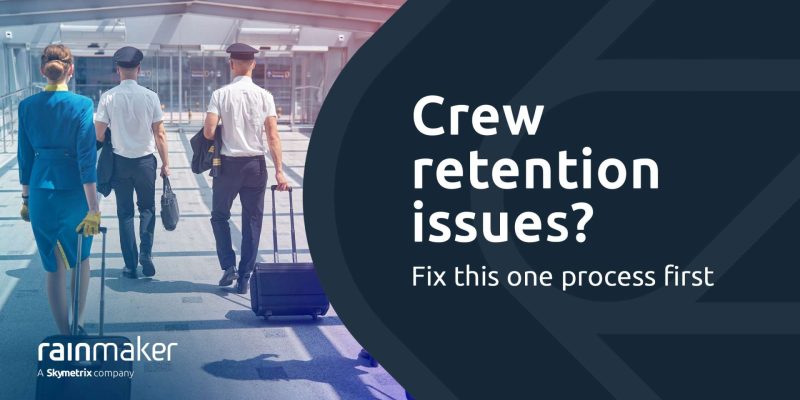
Recruiting and retaining flight crew is currently one of the biggest challenges facing the airline industry. It’s estimated there will be a shortage of 300,000 pilots within a decade (source) and that a worrying 63% of pilots plan to switch careers in the next year — up from 44% in 2020 (source).
On top of this, there’s the struggle to remain profitable. Thankfully, the profitability forecast for commercial aviation has significantly improved in recent months, but margins remain very slim (1.2% or just $2.25 per passenger — source.) As Wille Walsh, IATA’s Director General said, “repairing damaged balance sheets and providing investors with sustainable returns on their capital will continue to be a challenge for many airlines.”
It’s therefore crucial that airlines do all they can to enhance the employee experience so they retain crew, at the same time as getting the most from their crew so they can protect margins. But where do you start?
We suggest you focus on one key process first — ensuring your airline has an accurate, efficient and transparent crew pay process.
The traditional pay process is broken
Ensuring you pay your flight crew accurately and on time is the best — and most obvious — way to motivate them. Yet many airlines fail to achieve it. Why?
The key challenge comes from the Collective Agreements that dictate the rules for paying flight crew. These have become more and more complicated over time, which means that calculating pay in the typical way (using a combination of manual and automated processes) is now costly and prone to error. In our experience, a traditional pay process for an airline looks like this:
- Pay is usually calculated at the end of the bid period and processed through to payroll.
- Flight crew have no visibility of their pay until they get a statement after month end.
- The pay statement is often incorrect leading to a back-and-forth dialogue with pay administrators.
- Eventually issues are resolved, and everyone moves on to the next period to repeat the process.
- Finance managers have no opportunity to understand cost variances and intervene, so the experience remains the same.
Does this sound familiar to you? Unfortunately, this kind of pay process is all too common, and it is time-consuming, inefficient and frustrating for all involved.
Why that’s disastrous for airlines
When airlines fail to pay crew accurately first time around, it creates several major issues:
- Crew satisfaction and morale takes a hit. Inaccurate pay immediately erodes trust and damages the relationship between crew and the airline. While employees might forgive a one-off error, they’ll be much less amenable if mistakes keep happening. So don’t be surprised if your retention levels plummet.
- When challenged, many airlines overpay. By adopting an ‘if in doubt, overpay’ policy, carriers try to minimize fallout. However, it can cost the airline dearly, and it still fails to improve trust with flight crew. Profitability and staff retention are both negatively impacted in this scenario.
- Disputes and queries waste everyone’s time. Many airlines spend the two weeks after payroll is completed dealing with pay disputes and queries. Email and call volumes peak at these times. It’s a huge drain on time and resources.
- Unions often become involved. When pay disputes lead to formal processes being triggered, the challenges and costs further increase.
At a time when the relationship between an airline and its flight crew can often be adversarial, failing to pay crew correctly the first time, further erodes trust in the relationship.
How you can fix it
Don’t despair, there is a way through! By redesigning processes and harnessing the latest technology, it’s possible for airlines to pay flight crew accurately every time.
Firstly, you need to create the capability to calculate and process pay accurately according to all your complex pay rules and scenarios. This requires a fully automated system, which has been built specifically for the purpose.
Secondly, it’s vital to make your pay process more transparent. If you make it easy for crew members to understand their pay and see how it’s accruing after each shift, you can build trust, reduce disputes, and increase motivation, retention and loyalty. If you can also provide transparency to financial managers in near real-time — through reporting and analysis of crew pay — they can understand variances and spot issues earlier, such as scheduling inefficiencies. This transparency is best achieved with a cloud-based crew pay system, so it’s easily accessible for all staff, wherever they’re working.
Finally, it’s still important to offer ways for crew members to query their pay — even though this is much less likely to happen. It needs to be a fast, easy process, so problems can be resolved right away. Harnessing instant communication tools here, is the way to go.
How Rainmaker solutions can help
Rainmaker’s Crew Pay Manager solution transforms your pay process, increasing accuracy levels to 99%+ and reducing the associated labor costs by 80%. It’s an automated cloud-based solution providing transparency to all stakeholders involved in the pay process — crew members, finance managers, and Unions all love it.
As well as calculating and processing pay, it includes Crew Pay Analyzer — for high-level KPI tracking and in-depth analysis of crew pay costs — and an online system for logging and resolving queries fast.
If you’re ready to take control of your crew pay, and learn other ways to get the most from your crew, watch our webinar recording: Take your crew management to the next level




